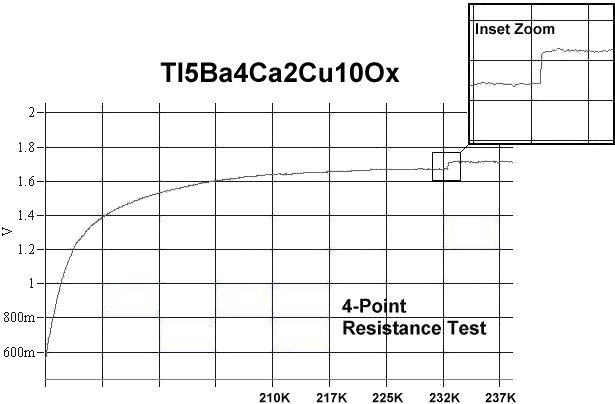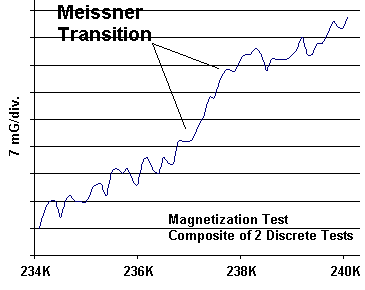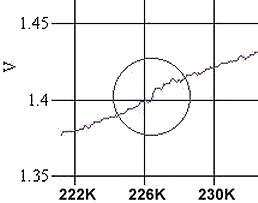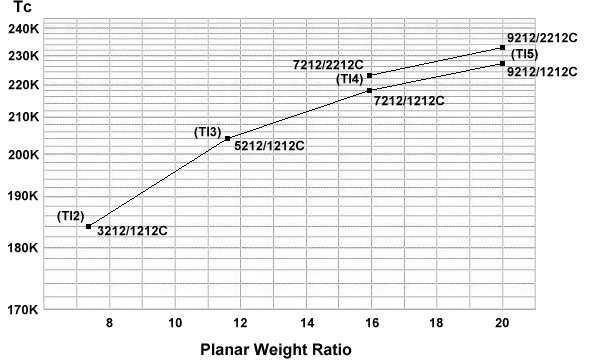

40 degrees below zero is cold by any measure. But, in the world of superconductors it's a record hot day. Superconductors.ORG herein reports an increase in high-Tc to 233K (-40C, -40F) through the substitution of thallium into the tin/indium atomic sites of the X212/2212C structure that produced a 218 Kelvin superconductor in January of 2009.
The host material producing the 233K signal has the chemical formula Tl5Ba4Ca2Cu10Oy. One of several resistance-v-temperature plots used to confirm this new record is shown above. And a composite magnetization test, showing the Meissner transition, is shown below right. A flashing line has been added to illustrate the diamagnetic shift in slope below Tc. The quiescent noise is a result of zooming in on a small volume fraction.

|
 This very high Tc material, like previous record discoveries, was designed to exploit planar weight disparity (PWD) along the "c" axis of the 9212/2212C structure (shown at left). In this case a very heavy insulating layer in the upper part of the structure (Tl5Cu4) opposes a single copper chain in the lower part. Even though the copper chain branches, the planar weight ratio remains high - around 20:1. The structure that produced the previous 218K record material had a PWR just over 16:1. |

Weaker resistive transitions also appeared near 227K, 223K and 218K. The 227K step (shown above) most likely results from a 9212/1212C structure forming as a minority phase; the 223K results from a 7212/2212C structure; and the 218K step from a 7212/1212C structure. Below 218K the other minority phases disappeared into the noise. As a result, a 1212C pellet with less thallium and copper was synthesized to discover the Tc of the 5212/1212C and 3212/1212C phases. In that pellet transitions appeared near 204K and 184K. All of these transitions were then plotted, producing the below Tc-v-PWR graph. The rate of slope declination suggests that 240K may be attainable.

Since we are now just a "stone's throw" from room temperature, this discovery is being released into the public domain without patent protection. Other researchers are encouraged to examine this material and its structure.
Synthesis of these materials was by the solid state reaction method. Stoichiometric amounts of the below precursors were mixed, pelletized and sintered for 34 hours at 865C. The pellet was then annealed for 10 hours at 500C in flowing O2.
Tl2O3 99.99% (Alfa Aesar) 7.136 grainsThe magnetometer employed twin Honeywell SS94A1F Hall-effect sensors with a tandem sensitivity of 50 mv/gauss. The 4-point probe was bonded to the pellet with CW2400 silver epoxy and used 7 volts on the primary.
RESEARCH NOTE: The copper-oxides are strongly hygroscopic. All tests should be performed immediately after annealing.

E. Joe Eck
© 2009 Superconductors.ORG
All rights reserved.
 BACK to "News" page at Superconductors.ORG
BACK to "News" page at Superconductors.ORG